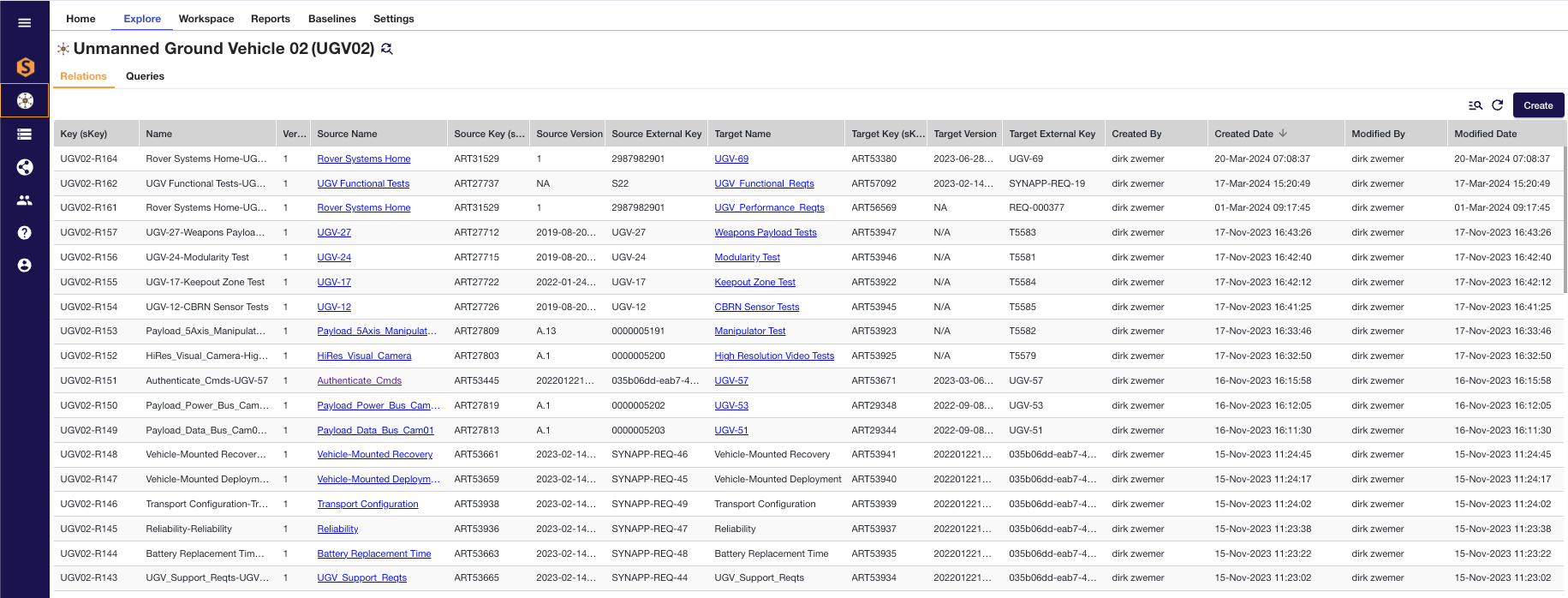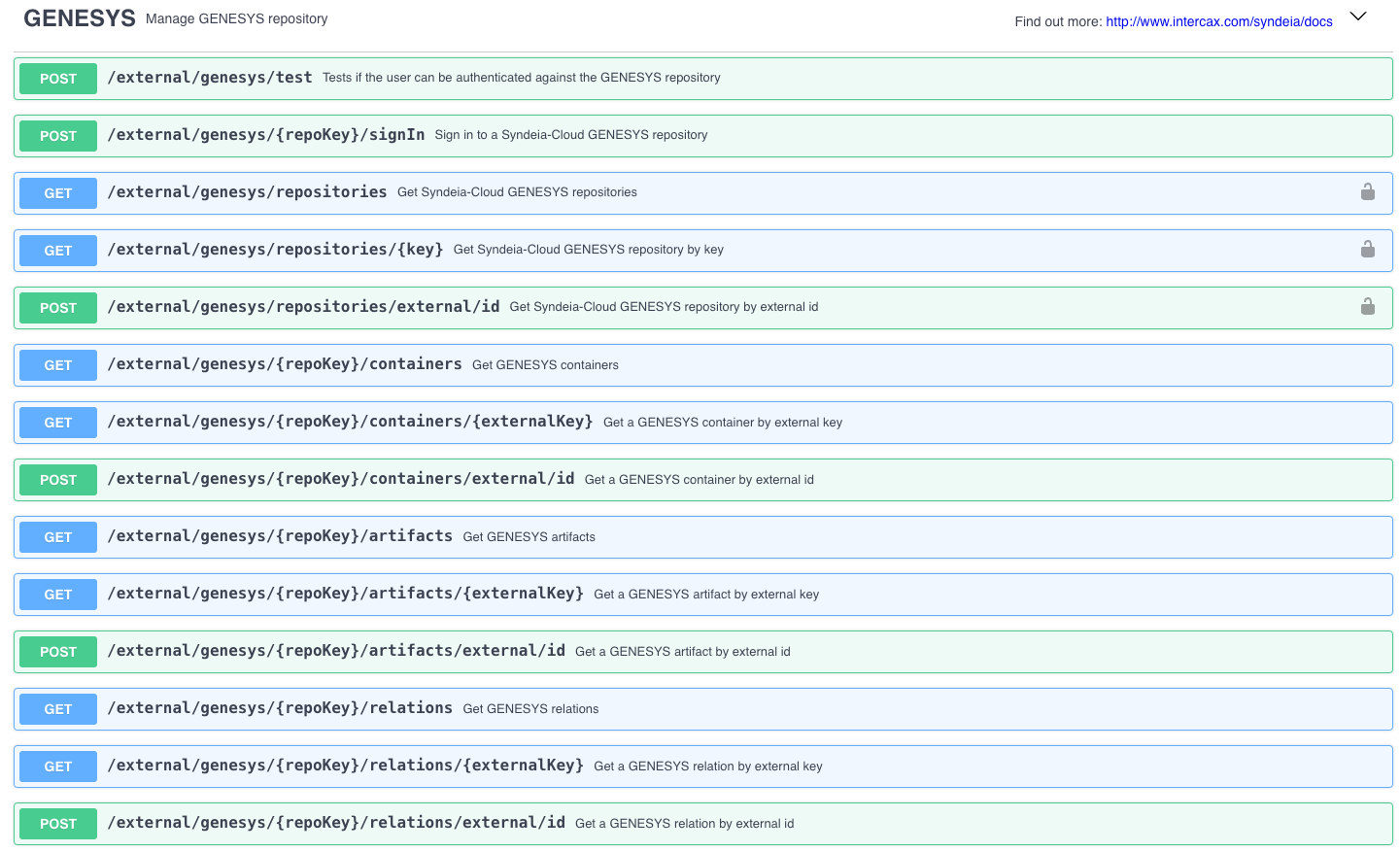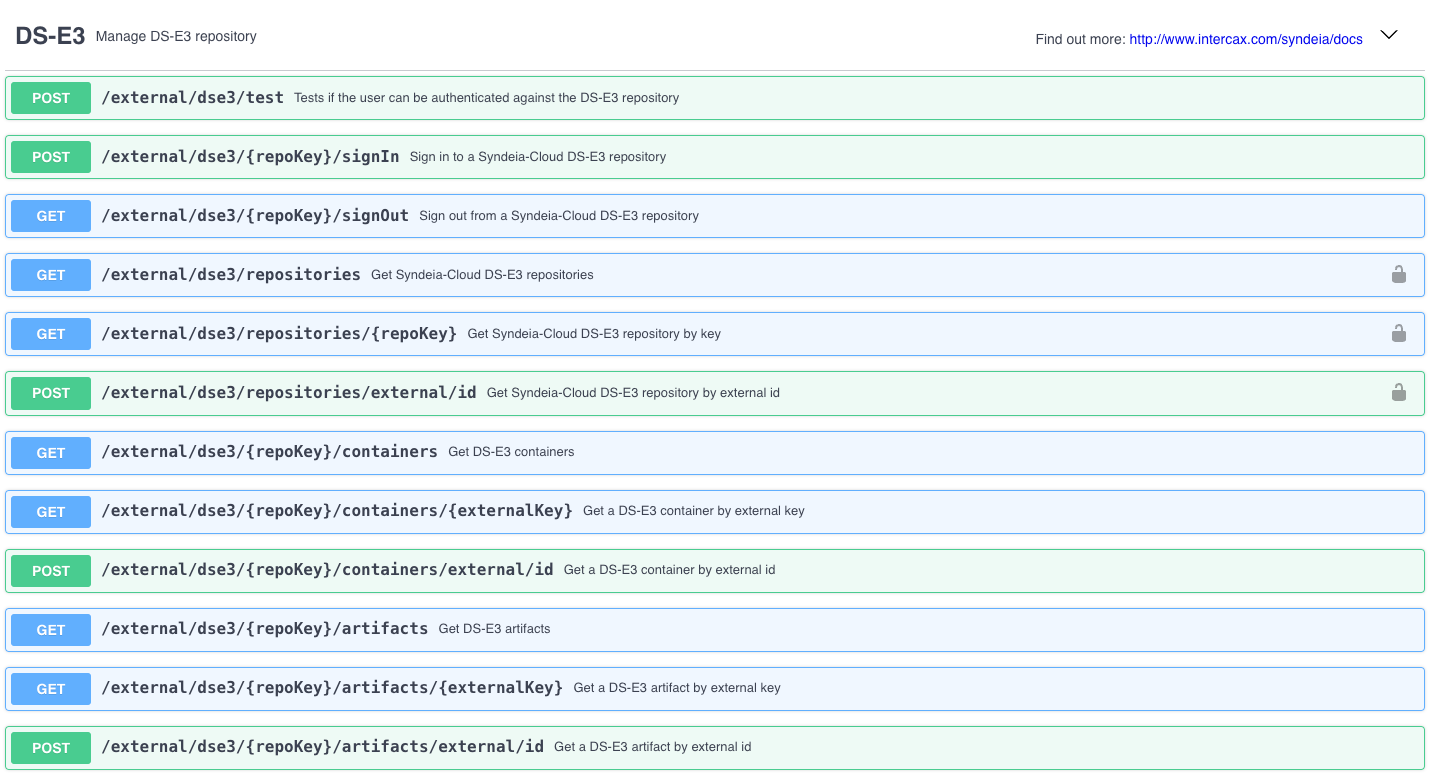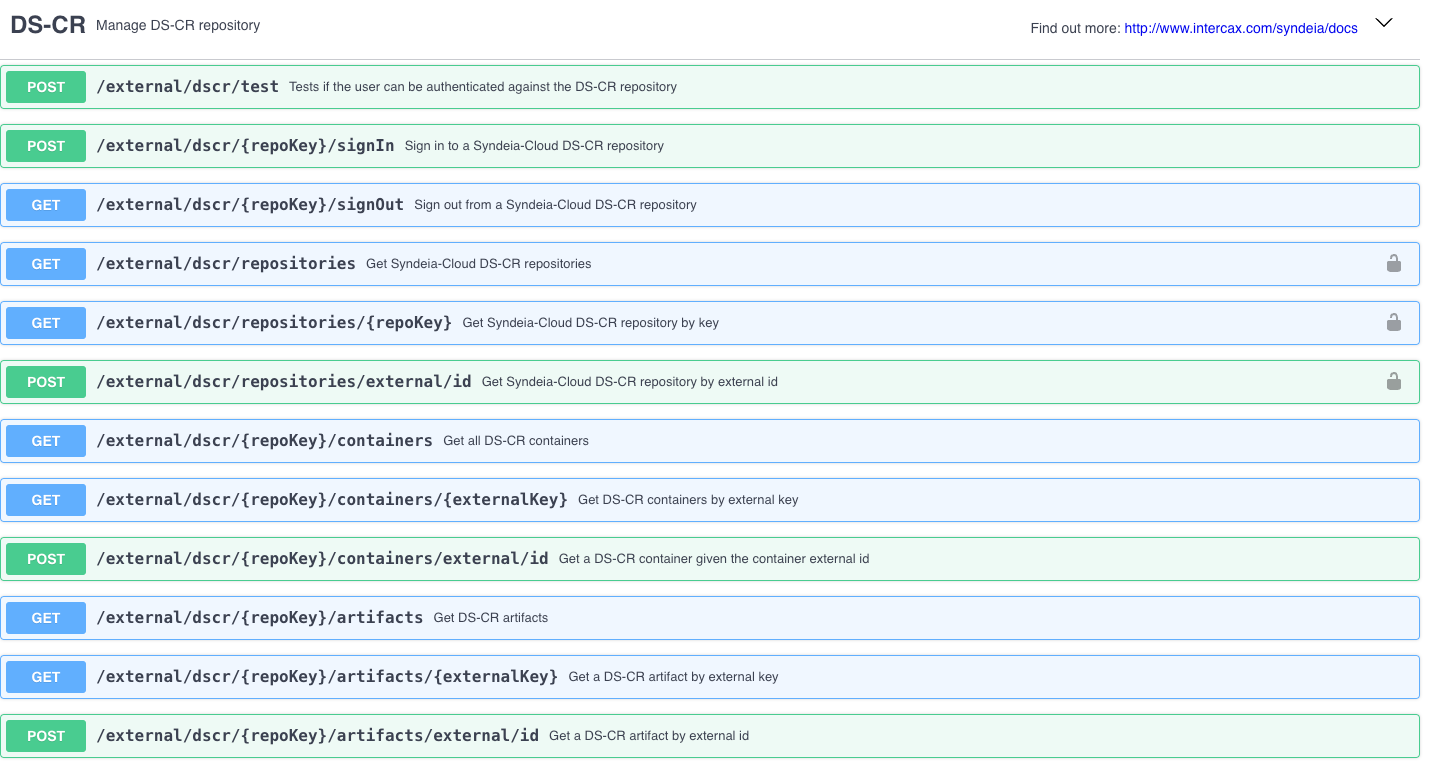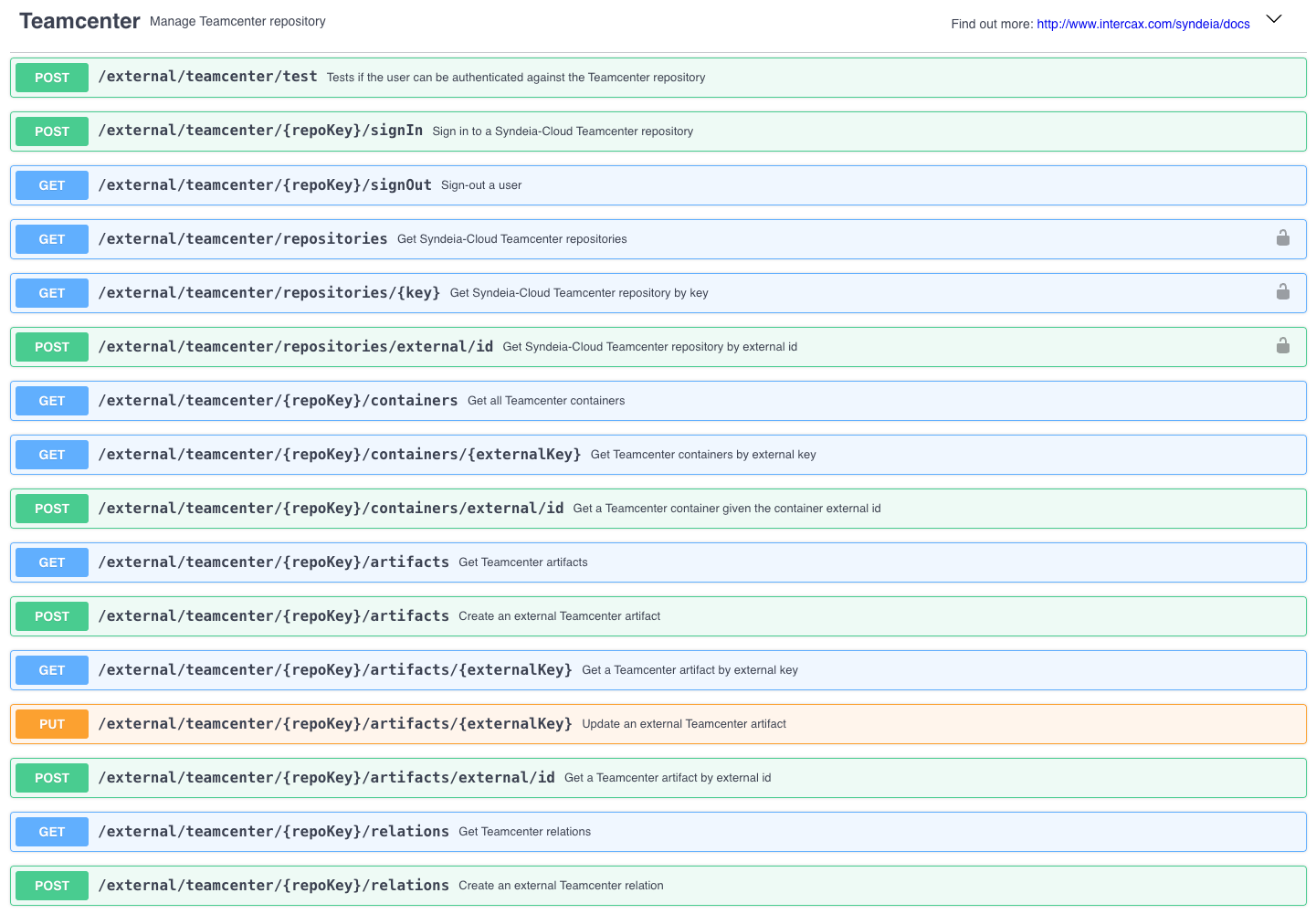
👋 Hello and Welcome to all! We are excited to release Syndeia 3.6, the next generation of our digital thread platform for model-based engineering. This release includes features that will accelerate concurrent digital engineering for mission-critical products and systems, all powered by enterprise-scale digital threads.
Digital Thread Projects are supercharged with a feature-rich dashboard that provides a “single pane of glass” for integrated digital engineering. The new Query Library capability will enable system integrators to develop collections of digital thread graph queries that can be played on-demand or scheduled via the API to generate system verification reports. Improvements in digital thread exploration facilitate live navigation of digital threads spanning integrated data sources and repositories, especially useful for project tracking, concurrent system design reviews, verification, and resolution. Digital thread analytics and reports provide live metrics that track project schedules, risk, and cost. Digital Thread Projects can be baselined and compared across milestones, enabling continuous integration and project releases. Global and Digital Thread Project-based user privilege management is upgraded for digital engineering teams with multiple stakeholders and roles.
Syndeia 3.6 brings three new integrations – GENESYS (Vitech/Zuken), DS-E3 (Zuken), and DS-CR (Zuken). The DS-E3 and DS-CR integrations will enable users to connect ECAD design models – Cable/Harness and Printed Circuit Board/Assembly – in digital threads. System engineers using the GENESYS MBSE platform can build scalable digital threads with data/models in hardware, software, verification, simulation, and other engineering disciplines. Teamcenter, one of the earliest integrations in Syndeia, is now live on the Syndeia Web Dashboard and API.
In addition to new features, this release includes hundreds of enhancements, new tutorial demonstrations, documentation updates, and bug fixes.
All new capabilities and improvements are backed by the powerful Syndeia Cloud REST API that enables organizations to develop automation solutions and seamlessly integrate Syndeia services with in-house digital engineering platforms. Syndeia comes with an API Cookbook containing Jupyter notebooks demonstrating the use of Syndeia Cloud REST API.
Thank you 🫶 to all Syndeia users and partners! This release includes several features based on your feedback and requests. We could not have done this without your support. We hope you will enjoy reading about all the new features and improvements in the section below. Thank you!
Table of Contents
New features and improvements in Syndeia 3.6 are presented here.
- 1 Digital Thread Projects and Dashboard
- 2 Syndeia Web Dashboard – Other Features & Improvements
- 3 New Integrations
- 4 Improvements to Existing Integrations
- 5 Syndeia Cloud REST API – New Features and Improvements
- 6 Quick Links
1. Digital Thread Projects and Dashboard
Syndeia 3.6 introduces new and comprehensive capabilities for Digital Thread Projects. A Digital Thread Project is a container for digital threads created between artifacts in different repositories/tools. In Syndeia, digital threads are organized using Digital Thread Projects. The term Digital Thread Project is being introduced in Syndeia 3.6 and replaces the term Syndeia Project.
1.1 Digital Thread Project Dashboard
Syndeia 3.6 introduces a new Digital Thread Project Dashboard that provides users a single pane of glass for accessing all the capabilities specific to a Digital Thread Project. Selecting a Digital Thread Project in the projects page opens the new dashboard. The capabilities are organized in six (6) tabs visible on the top of the dashboard and described below in this document.
1.2 Analytics and Timeline
The Home page of the Digital Thread Project Dashboard presents analytics and relation timelines for the project, as shown in the figure above. The analytics show the total number of digital thread relations and the total number and distribution (as pie charts) of artifacts, containers, and repositories participating in those relations. As an example, the figure above shows the Digital Thread Project Dashboard for the Unmanned Ground Vehicle 02 (key = UGV02) project. It has 142 digital thread relations between 224 artifacts owned by 8 containers from 8 different repositories. The two relation timelines show the growth of digital threads in the specific Digital Thread Project, incremental and cumulative over time.
1.3 Relations Management
Syndeia 3.6 introduces a new Relations table that shows all the digital thread relations for a given project. This is accessible from the Explore > Relations tab of the Digital Thread Project Dashboard. Source and target artifacts are hyperlinked and can be opened in native web applications. Users can search and create new digital thread relations if they have appropriate privileges.
1.4 Query Library and Visualization
Query libraries in Syndeia 3.6 provide a powerful capability for users to develop collections of digital thread queries that can be executed on demand or automatically via the API. Query libraries are accessible from the Explore > Queries tab of the Digital Thread Project Dashboard, as shown in the figure below. Query authors can develop collections of Gremlin graph queries that can be run by all participants on the Digital Thread Project. Users can run a single query or an entire collection and visualize results in the dashboard. Feature-rich controls for managing queries and visualization of results are available on the dashboard.
Users can develop queries for frequently asked questions (FAQs) on a project that can be run each day and presented during design reviews with stakeholders. This will enable a shift from document-based to model-based project tracking and reviews, powered by scalable digital threads managed by the Syndeia platform.
1.5 Repository Navigation, Search, and Digital Thread Exploration
Exploring the digital thread network and tracing through live relations, both within and across repositories, in the context of a Digital Thread Project has never been more easier and intuitive. With Syndeia 3.6, these capabilities are now also available in the context of a Digital Thread Project under the Workspace tab, as shown below. Selecting an artifact in the Repository Tree View will work as before and show both the intra (within) and inter (across) repository relations, the latter only for the specific Digital Thread Project. In the example shown below, Spacecraft Specification requirement in Jama Connect contains several child requirements, as visible in the Tree View and the Intra-model relations table on the RHS. In addition, it has an incoming inter-model relation (from a SysML requirement) in the context of the Spacecraft 2404 Digital Thread Project, as shown in the Inter-model relations table.
Navigating and search repositories, and using the Digital Thread Explorer in the context of a Digital Thread Project now gives users a focused view on inter-model (digital thread) relations specific to the given Digital Thread Project. This works for both the Tree View and the Graph View, as shown in the two figures below.
1.6 Baselines
With Syndeia 3.6, users can create Baselines for Digital Thread Projects. A Baseline represents the state of a Digital Thread Project and its contents at a specific point in time (timestamp). Users can create new baselines and compare baselines to review digital thread relations created, updated, and deleted between the baselines. Users can also compare a baseline with the current timestamp to learn about changes in the Digital Thread Project since the last baseline, or any given baseline. The Baseline feature is accessible from the Baselines tab of the Digital Thread Project Dashboard.
1.7 Reports
Syndeia 3.6 introduces web-based reports that provide a live status of artifacts connected in Digital Thread Projects. Users can view the latest state of connected Jira issues or Jama requirements in their Digital Thread Projects. The Jira report includes pie charts and table of issues, organized by status, type, priority, and assignee. The Jama report includes pie charts and tables of items, such as requirements, organized by status and priority. This capability is accessible from the Reports tab of the Digital Thread Project Dashboard. Digital Thread Project reports can provide a quick overview of the project completion status and bottlenecks
1.8 User Privileges
Syndeia 3.6 brings Privilege management to Digital Thread Projects. Syndeia admins can add, modify, or remove user privileges on Digital Thread Projects. Syndeia users can only view and work with Digital Thread Projects that are accessible to them. An extensive set of Global and Digital Thread Project permissions are available to assign to users based on their digital engineering needs. Bulk assignment of user privileges on a Digital Thread Project, and vice versa, are available for efficient management of users and projects. User privileges for a Digital Thread Project can be viewed and managed by admins from the Settings tab of the Digital Thread Project Dashboard, as shown in the figure below.
1.9 Accessible Digital Thread Projects
Syndeia 3.6 Web Dashboard includes a new Digital Thread Projects page accessible from the main menu bar. Syndeia users can view, search, and create Digital Thread Projects from this page. The table shows all the Digital Thread Projects accessible to the user.
2. Syndeia Web Dashboard – Other Features & Improvements
2.1 Global Dashboard
Syndeia 3.6 introduces a new Global Dashboard on the home page of the Syndeia Web Dashboard. The Global Dashboard shows global analytics and provides quick access to Digital Thread Projects available to the signed in user. The global analytics show the adoption and scale of digital threads on any given Syndeia Cloud deployment, such as total number of Digital Thread Projects and number of digital thread (inter-model) relations managed by these projects. They also show total number and distribution of artifacts, containers, and repositories connected by digital threads across all Digital Thread Projects. Global analytics also highlight the breadth of Digital Thread Projects and the usage of connected repositories across all projects.
2.2 Improvements in Graph Visualization
Syndeia 3.6 brings significant improvements to graph visualization capabilities across all areas of the Web Dashboard – Global Graph Queries, Digital Thread Explorer, and Digital Thread Project Query Library.
- Graph visualization controls have been added in a floating toolbar (LHS in the figure below) enabling users to easily pan, zoom, lock, refresh, and navigate large graphs. Keyboard and mouse controls continue to work as before.
- Bird’s eye view has been added to easily pan across sub-graphs of a large graph. This is great for design review sessions when running a playlist of queries for Digital Thread Projects.
- Rectangular node shapes are now the default based on popular demand from our users.
- Graph responsiveness has been improved.
- Right click on nodes and open in native web application (Jira, Jama, Teamcenter, Windchill, etc.) continues to work as before.
2.3 Global Graph Query Permissions
With the availability of Digital Thread Projects and Query Libraries, most Syndeia users will create and execute queries in the context of a Digital Thread Project. However, the capability to run global graph queries across ALL Digital Thread Projects is still available for advanced users. With Syndeia 3.6, users will require an additional privilege for Global Graph Queries to be added to their profile.
2.4 User Management
Syndeia 3.6 brings improvements to User management for local users and external users from LDAP and SSO/SAML2 identity providers. Syndeia admins can manage Global and Digital Thread Project privileges from the User Details page, as shown below. Bulk assignment of privileges, including adding, removing, or modifying user privileges on multiple Digital Thread Projects will simplify user management for Syndeia admins. In addition to detailed documentation on Global and Digital Thread Project privileges, we are also providing a General Recommendation guide for Syndeia admins with guidance on privilege management for most Syndeia end-users.
3. New Integrations
3.1 GENESYS (Vitech / Zuken)
Syndeia 3.6 brings integration to GENESYS (Vitech/Zuken) MBSE tool. Users can add and navigate GENESYS repositories directly from the Syndeia Web Dashboard or local clients. System components and requirements structure and relations can be navigated from the Tree View and Graph View, as shown in the figure below. Users can create digital thread relations between GENESYS artifacts and artifacts in any integrated repository, such as Jira, Teamcenter, Windchill, Jama, TestRail, and others.
3.2 DS-E3 (Zuken)
DS-E3 is Zuken’s next-generation data management system for electrical design data. Syndeia 3.6 introduces an integration to Zuken DS-E3. Users can add and navigate DS-E3 repositories, view projects, electrical devices and components, layout sheets, and physical parts in the Syndeia Web Dashboard, as shown below. Users can create digital thread relations between DS-E3 artifacts and artifacts in any integrated repository, such as Jira, SysML, Teamcenter, Windchill, Jama, TestRail, and others.
3.3 DS-CR (Zuken)
Zuken DS-CR is a leading ECAD platform for PCB design and data management. Syndeia 3.6 introduces an integration to Zuken DS-CR. Users can add and navigate DS-CR repositories, view projects, design boxes, parts, circuits, boards, and other design items in the Syndeia Web Dashboard, as shown below. Users can create digital thread relations between DS-CR artifacts and artifacts in any integrated repository, such as Jira, SysML, Teamcenter, Windchill, Jama, TestRail, and others.
4. Improvements to Existing Integrations
4.1 Teamcenter – Available on Syndeia Cloud (Web Dashboard and API)
Teamcenter has been one of the earliest integrations available with Syndeia. Starting with Syndeia 3.6, the Teamcenter integration is live on Syndeia Cloud. Users can connect to multiple Teamcenter repositories from the Web Dashboard, browse Teamcenter content, such as parts, requirements, requirement specifications, and other items, view item revisions and multi-level BOM structures (Precise and Imprecise), and cross-cutting trace links between Teamcenter items. This capability is available in both the Tree View and the Graph View as shown below. Model transformation capabilities between SysML and Teamcenter is already available via Syndeia clients. Users can also build digital thread relations with Teamcenter artifacts on the Web Dashboard and connect them to artifacts in any repository. Digital Thread Explorer will show both intra-model (within) and inter-model (across) relations from/to Teamcenter artifacts, as shown in the Graph View below.
4.2 Aras Innovator
4.2.1 Authentication Improvements
Syndeia 3.6 adds an improvement to OAuth2 authentication with Aras Innovator repositories. Users now have the option to input passwords which are converted to MD5 hash by default (per the Aras REST API), or directly provide a hashed input (e.g. SHA-256) if the Aras Innovator server is configured to accept the same.
4.2.2 Support for Web Alias
Syndeia 3.6 enables Aras Innovator users to add repositories that are configured with a non-default web alias. The general format for Aras Innovator server URLs is: https://{server-host}/{web alias}. Syndeia 3.5 uses the default web-alias (InnovatorServer). With Syndeia 3.6, users can provide the full Aras Innovator server URL with a custom web alias, e.g. https://myInnovator.myOrg.com/custom_web_alias. If a web alias is not provided, Syndeia will use the default web alias.
4.3 Windchill – Support for OAuth2
Syndeia 3.6 adds support for OAuth2 authentication with Windchill repositories using Ping Federate as the identity provider (IdP). When Ping Federate is configured as a SSO/SAML2 IdP with Windchill, admins can also configure Windchill to use OAuth2 with Ping Federate for a pure API-based authentication flow. Syndeia 3.6 users will be able to connect to Windchill via OAuth2 authentication protocol. Users can initiate OAuth2 connection to Windchill in the Syndeia Web Dashboard. Syndeia will redirect them to the Ping Federate IdP for sign-in, and once approved, users will be able to browse Windchill repositories in the Web Dashboard, both in the Tree View and Graph View, as shown in the figure below.
4.4 VOLTA – Authentication Improvements
Syndeia 3.6 introduces API Key based authentication for VOLTA repositories. In addition to credentials (username/password), Syndeia users can also authenticate with VOLTA repositories using API keys available for their accounts from the VOLTA web application.
4.5 DOORS-NG – Mapping and Transform Improvements for Component Streams
Syndeia 3.6 brings significant improvements to the DOORS-NG integration, backed by the Syndeia Cloud API. Users can create artifact types for streams in components of DOORS-NG projects, and use them in defining custom mappings. Model transformation, and compare and sync operations based on custom mappings are better supported for non-default streams of project components.
5. Syndeia Cloud REST API – New Features and Improvements
Syndeia Cloud is an API-first platform. All of the new and improved capabilities available with Syndeia Cloud 3.6 via the Web Dashboard and Client Dashboards are backed by the feature-rich Syndeia Cloud REST API. The key updates are presented in this section.
5.1 Digital Thread Project Service & Endpoints
Syndeia Cloud 3.6 REST API includes dedicated endpoints for working with Digital Thread Projects. All the Digital Thread Project capabilities presented on the Web Dashboard are backed by these endpoints. Some of the key API features include:
- Projects – Fetch and query Digital Thread Projects accessible to a user
- Relations – Create, query, and manage relations in Digital Thread Projects
- Query Library – Create, manage, and execute queries and collections for Digital Thread Projects
- Baselines – Create, manage, and compare baselines of Digital Thread Projects
- User Privileges – Manage user privileges on Digital Thread Projects
5.2 GENESYS Service and Endpoints
The new GENESYS integration available in the Syndeia 3.6 Web Dashboard and Client Dashboard is backed by dedicated endpoints available for the GENESYS service. API endpoints for navigating GENESYS repositories, projects, and fetching artifacts, such as Components and Requirements, and their structural relationships are available. The Tree View and Graph View for GENESYS on the Syndeia Cloud Web Dashboard is backed by these endpoints. The figure below shows a subset of endpoints.
5.3 DS-E3 Service and Endpoints
The new DS-E3 integration available in the Syndeia 3.6 Web Dashboard and Client Dashboard is backed by dedicated endpoints available for the DS-E3 service. API endpoints for navigating DS-E3 repositories, projects, and fetching artifacts, such as BOM items, Circuits, and Parts are available. The Tree View and Graph View for DS-E3 on the Syndeia Cloud Web Dashboard is backed by these endpoints. The figure below shows a subset of endpoints.
5.4 DS-CR Service and Endpoints
The new DS-CR integration available in the Syndeia 3.6 Web Dashboard and Client Dashboard is backed by dedicated endpoints available for the DS-CR service. API endpoints for navigating DS-CR repositories, projects, and fetching artifacts, such as Design Boxes, Boards, Circuits, Parts, and Design Items are available. The Tree View and Graph View for DS-CR on the Syndeia Cloud Web Dashboard is backed by these endpoints. The figure below shows a subset of endpoints.
5.5 Teamcenter Service and Endpoints
The new Teamcenter integration available in the Syndeia 3.6 Web Dashboard is backed by dedicated endpoints available for the Teamcenter service. API endpoints for navigating Teamcenter repositories, and artifacts such as items and item revisions, and all their subtypes (e.g. Parts, Requirements, Requirement Specification) are available. Relation endpoints for fetching BOM structure and trace links are also available. The Tree View and Graph View for Teamcenter on the Syndeia Cloud Web Dashboard is backed by these endpoints. A subset of endpoints is shown below.
5.6 DOORS-NG Service and Endpoints
Syndeia 3.6 includes significant improvements to the DOORS-NG service endpoints for creating (POST) and updating (PUT) artifacts and relations in components and streams. The improved capabilities for model transformation and sync in DOORS-NG project components and streams is backed by these endpoints.
Quick Links:
Learn about the live Syndeia training program here. Enroll now, sessions start from May 22nd, 2024.
Have questions? Reach us at info@intercax.com.
Need an evaluation license? Request one at our helpdesk.
What’s New in Syndeia 3.6
Click here for the complete list of new features and improvements in Syndeia 3.6.
 Intercax
Intercax Intercax
Intercax
